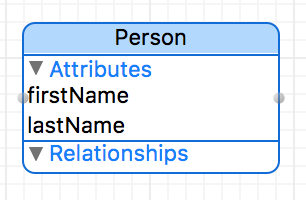
DPS923 & MAP523
Mobile App Development for iOS
Notes Topics Weekly Resources Graded work Professor Code examplesCore Data Introduction
Core Data is an object design, management, and persistence framework.
It enables you manage the lifecycle of objects and object graphs that are in memory.
The object graph can be simple (e.g. a variable, or an entity object, or a collection), or it can be complex (e.g. many entity object collections, some of which are related to others).
Also, read the brief Wikipedia article on object graph.
In our apps, we are always using objects and collections of objects, in memory. Core Data enables us to focus on these programming constructs, without worrying about storage-related concerns. In our program code, we use built-in Swift language-based querying to do the typical data service operations (e.g. load, fetch, add, change, save, etc.).
The file format of Core Data on-device storage is essentially unimportant to us.
While it is typically stored in a relational database management system (based on SQLite), we do not, can not, and must not think of Core Data as a database.
Comparing and/or equating Core Data and relational database management system technologies (including ORM, object-relational mapping) is a mistake.
Designing a class in Swift, and designing an entity in Core Data model editor, are very similar.
A Person class in Swift might look like this:
class Person {
var firstName: String?
var lastName: String?
}
Similarly, the Core Data model editor enables us to design an entity named “Person”, and it would have two property attributes named “firstName” and “lastName”, both of type String.
Here’s the editor in table view:

Here’s the editor in graph view:

How do I get started?
Use a project template. In the course’s GitHub repository, in the Templates_and_solutions folder, you will see a project named TemplateCDv1.
Make a copy of that, and you will have all you need to start working on a new project.
How do I make a copy?
The “readme” file in the project helps you do this.
Where do I go from here
Pay attention to the topic discussion and delivery from your professor. This is a challenging topic set, and your professor will guide you through the thought process and skill acquisition phase.
Get the “Canada” code example that’s in the Week 8 folder of the repository. Study all parts of that app. Use it, add data, notice its features and functionality.
Apple reference info
Apple has a start page for the Core Data framework. It has an overview, and links to topics.
Apple also publishes a Core Data Programming Guide.
While useful, essential, and authoritative, it does not include the advanced engineering that has been put into the template (above). As a result, when you’re going through the Apple programming guide, read critically, in the event that something it covers (e.g. “Initializing the Core Data Stack”) sounds different that what you’ve learned recently.
You will notice that the programming guide’s most recent revision was a couple of years ago.